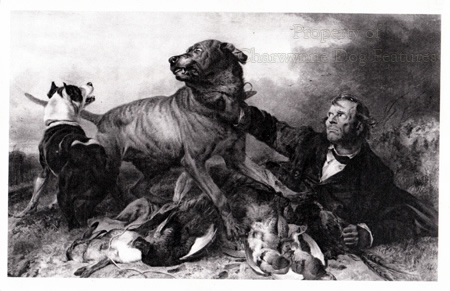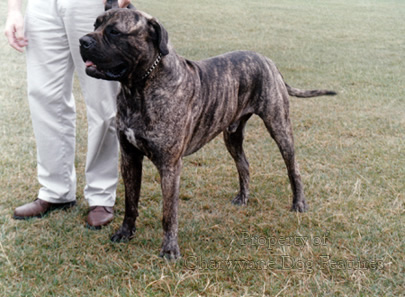888 BRING BACK THE NIGHT-DOG
BRING BACK THE NIGHT-DOG
by David Hancock
 "In many parts of the country it is the custom for keepers and watchmen to be provided with night-dogs, and useful co-adjutors they make if only they have been properly trained...Usually the Bull-Mastiff is the breed selected for the purpose, and brindle if possible."
"In many parts of the country it is the custom for keepers and watchmen to be provided with night-dogs, and useful co-adjutors they make if only they have been properly trained...Usually the Bull-Mastiff is the breed selected for the purpose, and brindle if possible."
'Breaking and Training Dogs' by 'Pathfinder' 1906
It never ceases to surprise me that in the countryside in Britain today, with rural crime disturbingly high, that greater use isn't made of the old night-dogs. Our Bullmastiff is usually described in articles on dogs only in its one time role as the gamekeepers' night-dog, a significant advance for this distinct type of dog. For the first time, it seems, it was appreciated that there was a breed-type between the big Mastiff and the smaller Bulldog. It is significant that the Bullmastiff type predominates in the mastiff breeds of the world, with the French and Spanish breeds and the Boerboel of South Africa being closer to this type than the Mastiff of England. In France such a dog would have been called a chien de nuit or chien du guet, with the French artist Agasse depicting a kennel of them. The French also favoured the shepherd-dog type, the breed of Beauceron especially, referring to them as 'chiens de contre-braconnage' or anti-poaching dogs.
.jpg)

 In Germany, the dog used was referred to as a 'grosse bullenbeisser' and in Denmark as a 'Danish Dog', with 'dog' as used here meaning mastiff-type not dog the domestic animal generally. Around 1850, in Denmark, Sehested started to re-create the old Danish dog, now called the Broholmer after his estate at Funen. He knew full well that there had been an intermediate mastiff-like dog, in between the Brabanter/Boxer size and the much heavier mastiff type. Only in Britain did the in-between dog lack recognition. Incidentally, gamekeeper Crabtree's long, low, brindle "mastiff" bitch, named 'Duchess' by him, was mated to Holdsworth's 'Lion' of the Bold Hall strain. A bitch from this mating was later mated by Crabtree to Waterton's 'Tiger', a red fawn Great Dane, illustrating very clearly the mixed and often unknown breeding behind the dogs used by gamekeepers.
In Germany, the dog used was referred to as a 'grosse bullenbeisser' and in Denmark as a 'Danish Dog', with 'dog' as used here meaning mastiff-type not dog the domestic animal generally. Around 1850, in Denmark, Sehested started to re-create the old Danish dog, now called the Broholmer after his estate at Funen. He knew full well that there had been an intermediate mastiff-like dog, in between the Brabanter/Boxer size and the much heavier mastiff type. Only in Britain did the in-between dog lack recognition. Incidentally, gamekeeper Crabtree's long, low, brindle "mastiff" bitch, named 'Duchess' by him, was mated to Holdsworth's 'Lion' of the Bold Hall strain. A bitch from this mating was later mated by Crabtree to Waterton's 'Tiger', a red fawn Great Dane, illustrating very clearly the mixed and often unknown breeding behind the dogs used by gamekeepers.
In his 'The Gamekeeper at Home' of 1879, Richard Jeffries recounts the sort of desperate situation in which Keeper's Night-dogs were regularly placed: "In the last party (the squire's) were six men and a mastiff dog; four of the men had guns, the gentleman only a stout cudgel. They came upon the gang (of poachers) in a drive deep in shadow. With a shout the four or five men in the drive or green lane, slipped back behind the trees, and two fired, killing the mastiff dog on the spot and 'stinging' one man in the legs." It is interesting that the poachers made a high priority of killing the dog.
In his classic 'Dog Breaking' of 1909, the esteemed General Hutchinson was writing of a night-dog: "The appearance of the formidable-looking animal, and the knowledge of his powers, more effectually prevented egg-stealing than would the best exertions of a dozen watchers. He was the terror of all the idle boys in the neighbourhood. Every lad felt assured that, if once 'Growler' were put upon his footsteps, to a certainty he would be overtaken, knocked down, and detained until the arrival of the keeper." There is a canine instinct being capitalised upon very effectively. In his 'Recollections – Poachers, of 1850, Grantley Berkeley, wrote: "The first dog I could call my own was a black one, of a cross between the bull and the mastiff...His name was 'Grumbo'...I saw the back of one of the men, his figure stationary, his hands held high above his head, and Grumbo, my faithful, sagacious dog, a yard in front of him, barring his path, couched like a lion in the act to spring, his eyes, not his teeth, fixed on the fellow's throat. The menace sufficed, he stood in terror...and in this position I presently seized him by the collar." The Bulldog-Mastiff cross was clearly both known and respected.
'Stonehenge', writing in his 'Dogs of the British Islands', gave us this view: "...there is probably no variety of the species which combines so much strength and power of doing mischief with such docility and amiability, and hence he is, par excellence, the keeper's dog...every one of experience knows that many keeper's dogs, which are fully half bull, are perfectly under control even with severe provocation..." There is the best possible terminology for the Breed Standard's words on temperament in the breed! The essential character needed in a night-dog was neatly summarized by 'Wildfowler' in his section entitled 'Training a Keeper's Night Dog' from his book 'Dog Breaking' of 1915: "...it is better to have a very large animal, whose growls alone are somewhat terrifying, and whose size is bound to impose respect. At the same time, growling is not sufficient; the dog must be able and willing at any time to 'go in' at a nod from his master, and he must take his death, if necessary, when called upon to protect him." Scary words but criminals can be scary too!
